Impact of Equality and Diversity on Business Performance
VerifiedAdded on 2023/01/12
|22
|5221
|22
Project
AI Summary
This project analyzes the impact of equality and diversity on business performance, using CafePod, a small independent coffee company, as a case study. The project begins with an executive summary and introduction, defining equality and diversity and their importance. It outlines project aims, objectives, and research questions, followed by a detailed project management plan including timeframes, stages, work breakdown structure, and a Gantt chart. The research methodology focuses on primary data collection methods. Data analysis and interpretation are presented, leading to specific recommendations. The project concludes with a reflection and a conclusion summarizing the findings. The project aims to analyze the concept and benefits of implementing equality and diversity, and determine its impact on business performance. The project employs primary research methods like questionnaires and surveys to gather first-hand data. The project also includes secondary research methods to support the findings and recommendations.
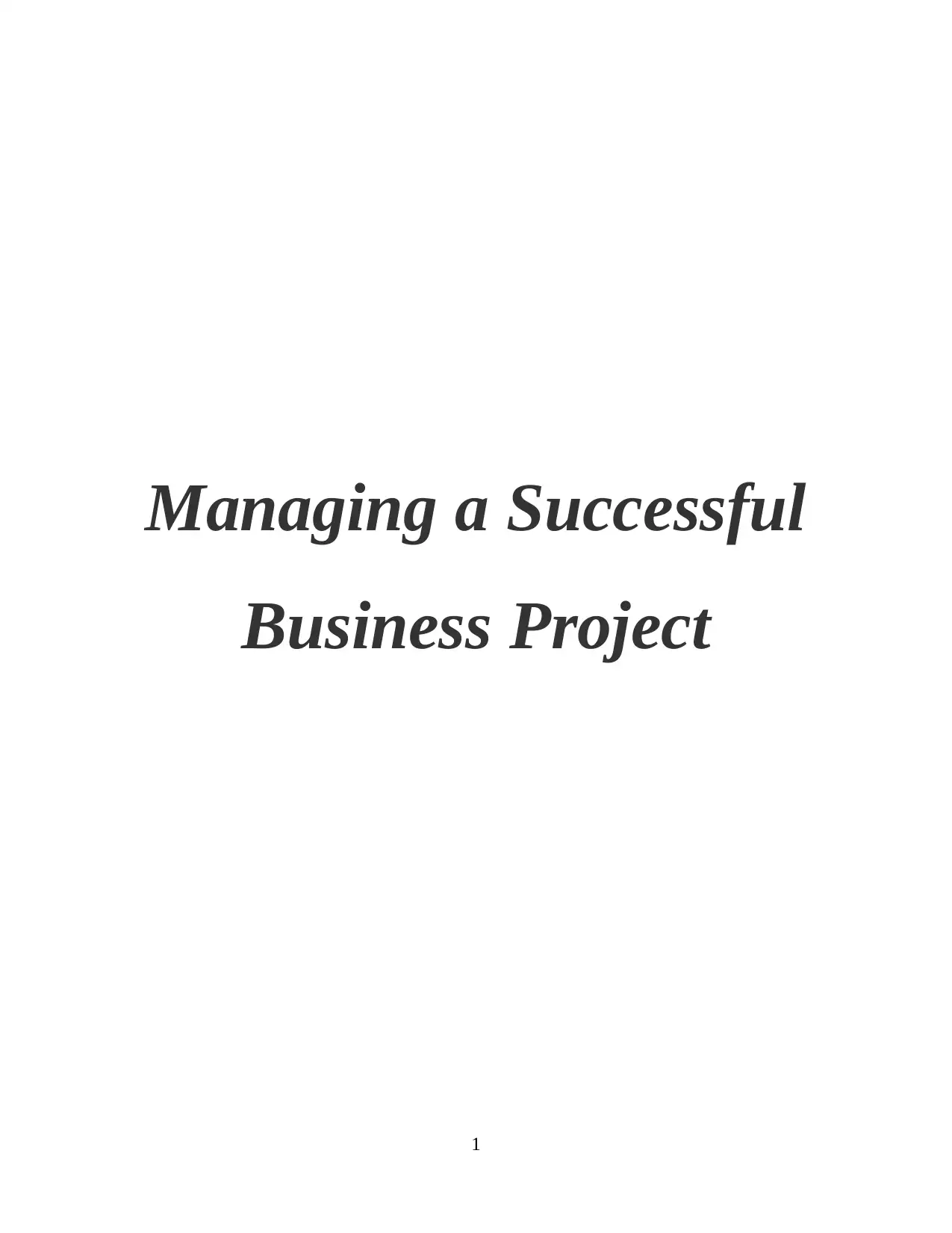
Managing a Successful
Business Project
1
Business Project
1
Paraphrase This Document
Need a fresh take? Get an instant paraphrase of this document with our AI Paraphraser
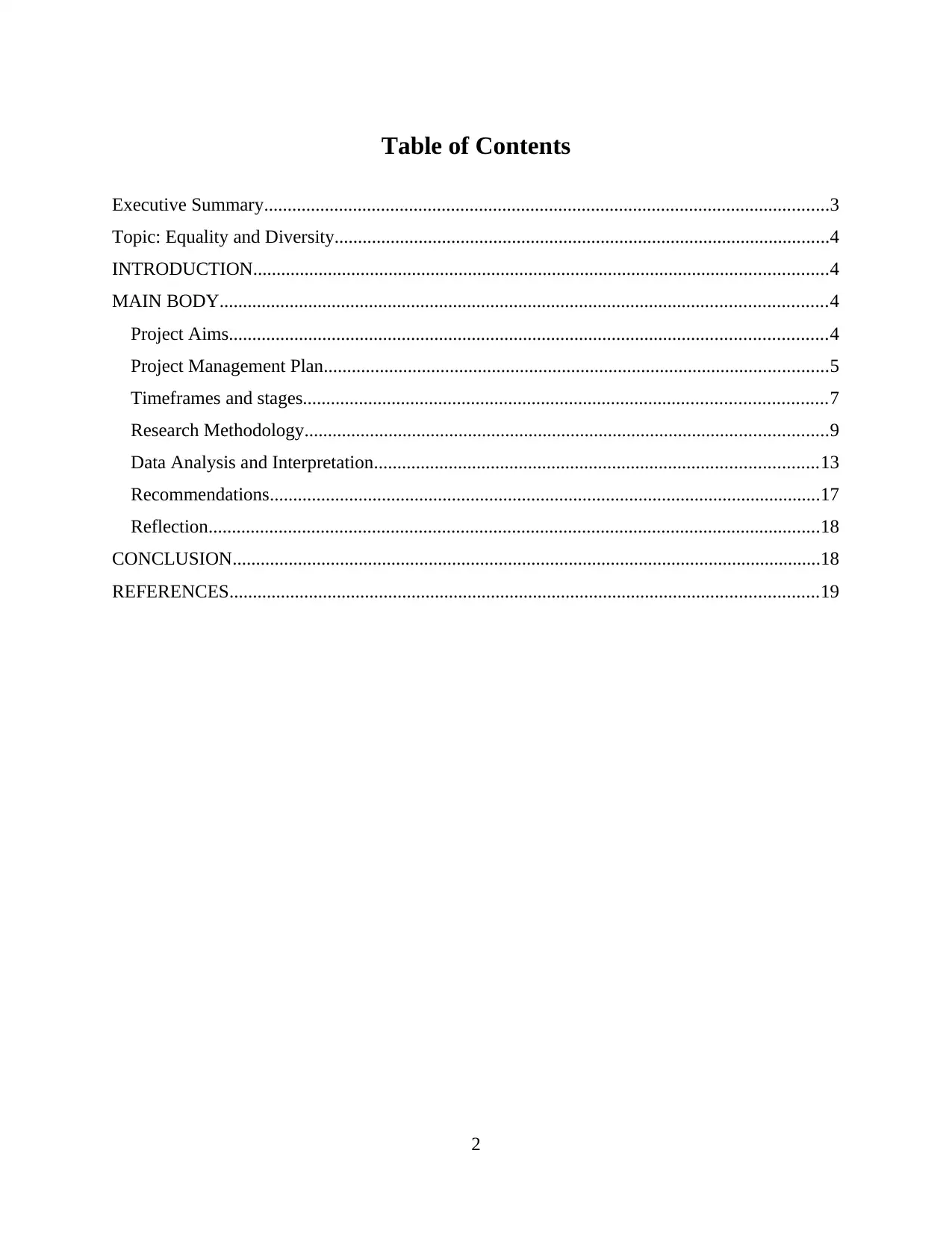
Table of Contents
Executive Summary.........................................................................................................................3
Topic: Equality and Diversity..........................................................................................................4
INTRODUCTION...........................................................................................................................4
MAIN BODY..................................................................................................................................4
Project Aims................................................................................................................................4
Project Management Plan............................................................................................................5
Timeframes and stages................................................................................................................7
Research Methodology................................................................................................................9
Data Analysis and Interpretation...............................................................................................13
Recommendations......................................................................................................................17
Reflection...................................................................................................................................18
CONCLUSION..............................................................................................................................18
REFERENCES..............................................................................................................................19
2
Executive Summary.........................................................................................................................3
Topic: Equality and Diversity..........................................................................................................4
INTRODUCTION...........................................................................................................................4
MAIN BODY..................................................................................................................................4
Project Aims................................................................................................................................4
Project Management Plan............................................................................................................5
Timeframes and stages................................................................................................................7
Research Methodology................................................................................................................9
Data Analysis and Interpretation...............................................................................................13
Recommendations......................................................................................................................17
Reflection...................................................................................................................................18
CONCLUSION..............................................................................................................................18
REFERENCES..............................................................................................................................19
2
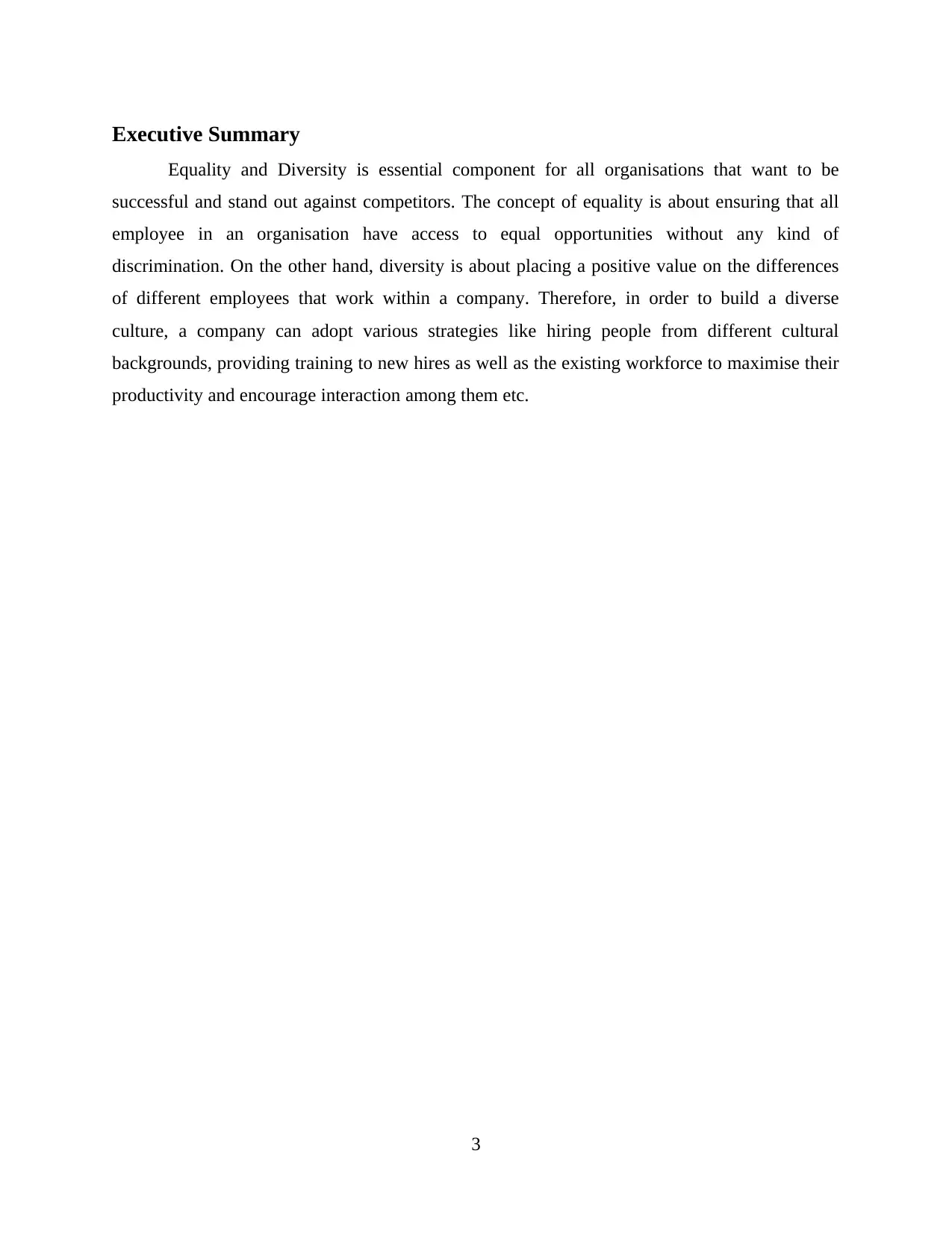
Executive Summary
Equality and Diversity is essential component for all organisations that want to be
successful and stand out against competitors. The concept of equality is about ensuring that all
employee in an organisation have access to equal opportunities without any kind of
discrimination. On the other hand, diversity is about placing a positive value on the differences
of different employees that work within a company. Therefore, in order to build a diverse
culture, a company can adopt various strategies like hiring people from different cultural
backgrounds, providing training to new hires as well as the existing workforce to maximise their
productivity and encourage interaction among them etc.
3
Equality and Diversity is essential component for all organisations that want to be
successful and stand out against competitors. The concept of equality is about ensuring that all
employee in an organisation have access to equal opportunities without any kind of
discrimination. On the other hand, diversity is about placing a positive value on the differences
of different employees that work within a company. Therefore, in order to build a diverse
culture, a company can adopt various strategies like hiring people from different cultural
backgrounds, providing training to new hires as well as the existing workforce to maximise their
productivity and encourage interaction among them etc.
3
⊘ This is a preview!⊘
Do you want full access?
Subscribe today to unlock all pages.

Trusted by 1+ million students worldwide
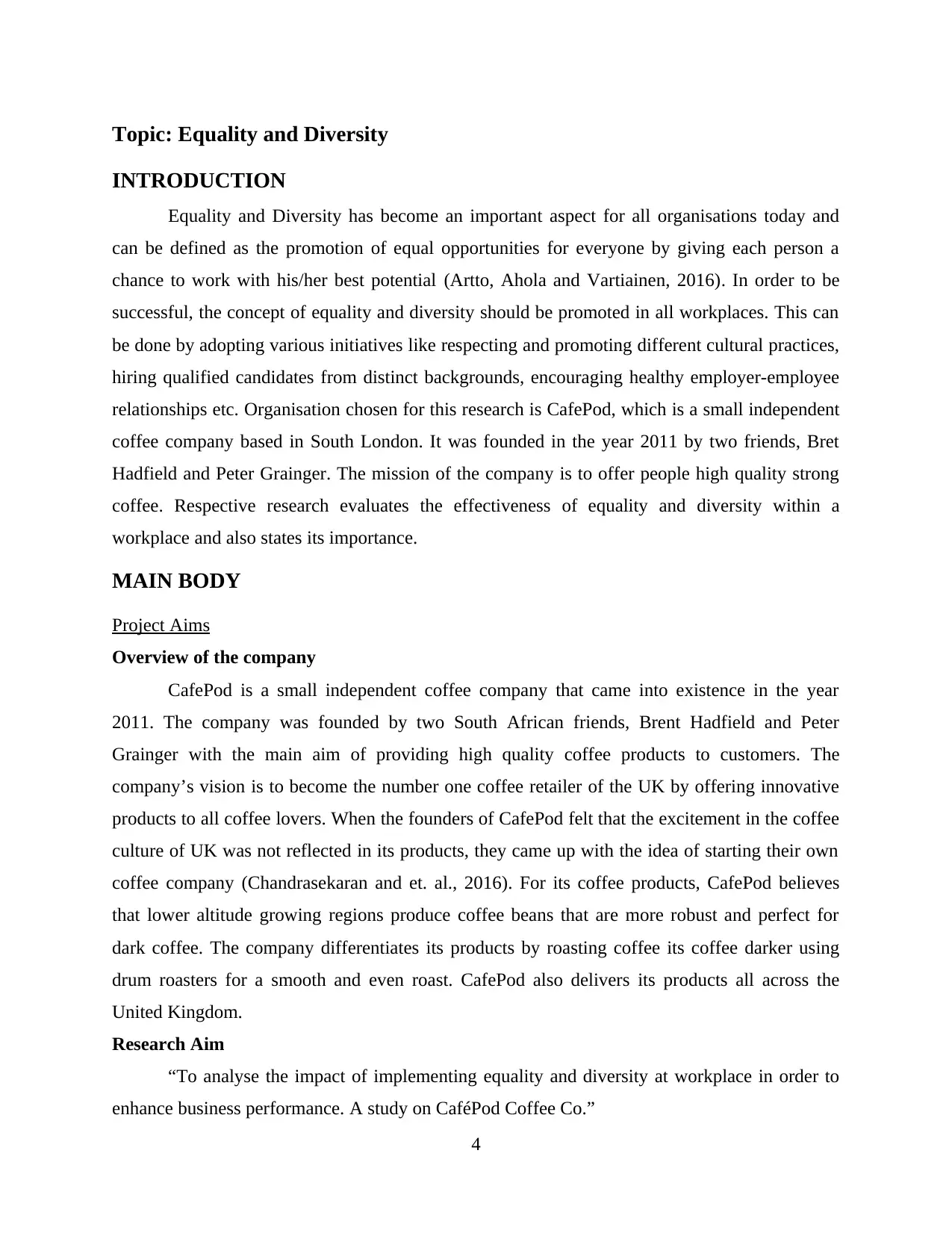
Topic: Equality and Diversity
INTRODUCTION
Equality and Diversity has become an important aspect for all organisations today and
can be defined as the promotion of equal opportunities for everyone by giving each person a
chance to work with his/her best potential (Artto, Ahola and Vartiainen, 2016). In order to be
successful, the concept of equality and diversity should be promoted in all workplaces. This can
be done by adopting various initiatives like respecting and promoting different cultural practices,
hiring qualified candidates from distinct backgrounds, encouraging healthy employer-employee
relationships etc. Organisation chosen for this research is CafePod, which is a small independent
coffee company based in South London. It was founded in the year 2011 by two friends, Bret
Hadfield and Peter Grainger. The mission of the company is to offer people high quality strong
coffee. Respective research evaluates the effectiveness of equality and diversity within a
workplace and also states its importance.
MAIN BODY
Project Aims
Overview of the company
CafePod is a small independent coffee company that came into existence in the year
2011. The company was founded by two South African friends, Brent Hadfield and Peter
Grainger with the main aim of providing high quality coffee products to customers. The
company’s vision is to become the number one coffee retailer of the UK by offering innovative
products to all coffee lovers. When the founders of CafePod felt that the excitement in the coffee
culture of UK was not reflected in its products, they came up with the idea of starting their own
coffee company (Chandrasekaran and et. al., 2016). For its coffee products, CafePod believes
that lower altitude growing regions produce coffee beans that are more robust and perfect for
dark coffee. The company differentiates its products by roasting coffee its coffee darker using
drum roasters for a smooth and even roast. CafePod also delivers its products all across the
United Kingdom.
Research Aim
“To analyse the impact of implementing equality and diversity at workplace in order to
enhance business performance. A study on CaféPod Coffee Co.”
4
INTRODUCTION
Equality and Diversity has become an important aspect for all organisations today and
can be defined as the promotion of equal opportunities for everyone by giving each person a
chance to work with his/her best potential (Artto, Ahola and Vartiainen, 2016). In order to be
successful, the concept of equality and diversity should be promoted in all workplaces. This can
be done by adopting various initiatives like respecting and promoting different cultural practices,
hiring qualified candidates from distinct backgrounds, encouraging healthy employer-employee
relationships etc. Organisation chosen for this research is CafePod, which is a small independent
coffee company based in South London. It was founded in the year 2011 by two friends, Bret
Hadfield and Peter Grainger. The mission of the company is to offer people high quality strong
coffee. Respective research evaluates the effectiveness of equality and diversity within a
workplace and also states its importance.
MAIN BODY
Project Aims
Overview of the company
CafePod is a small independent coffee company that came into existence in the year
2011. The company was founded by two South African friends, Brent Hadfield and Peter
Grainger with the main aim of providing high quality coffee products to customers. The
company’s vision is to become the number one coffee retailer of the UK by offering innovative
products to all coffee lovers. When the founders of CafePod felt that the excitement in the coffee
culture of UK was not reflected in its products, they came up with the idea of starting their own
coffee company (Chandrasekaran and et. al., 2016). For its coffee products, CafePod believes
that lower altitude growing regions produce coffee beans that are more robust and perfect for
dark coffee. The company differentiates its products by roasting coffee its coffee darker using
drum roasters for a smooth and even roast. CafePod also delivers its products all across the
United Kingdom.
Research Aim
“To analyse the impact of implementing equality and diversity at workplace in order to
enhance business performance. A study on CaféPod Coffee Co.”
4
Paraphrase This Document
Need a fresh take? Get an instant paraphrase of this document with our AI Paraphraser
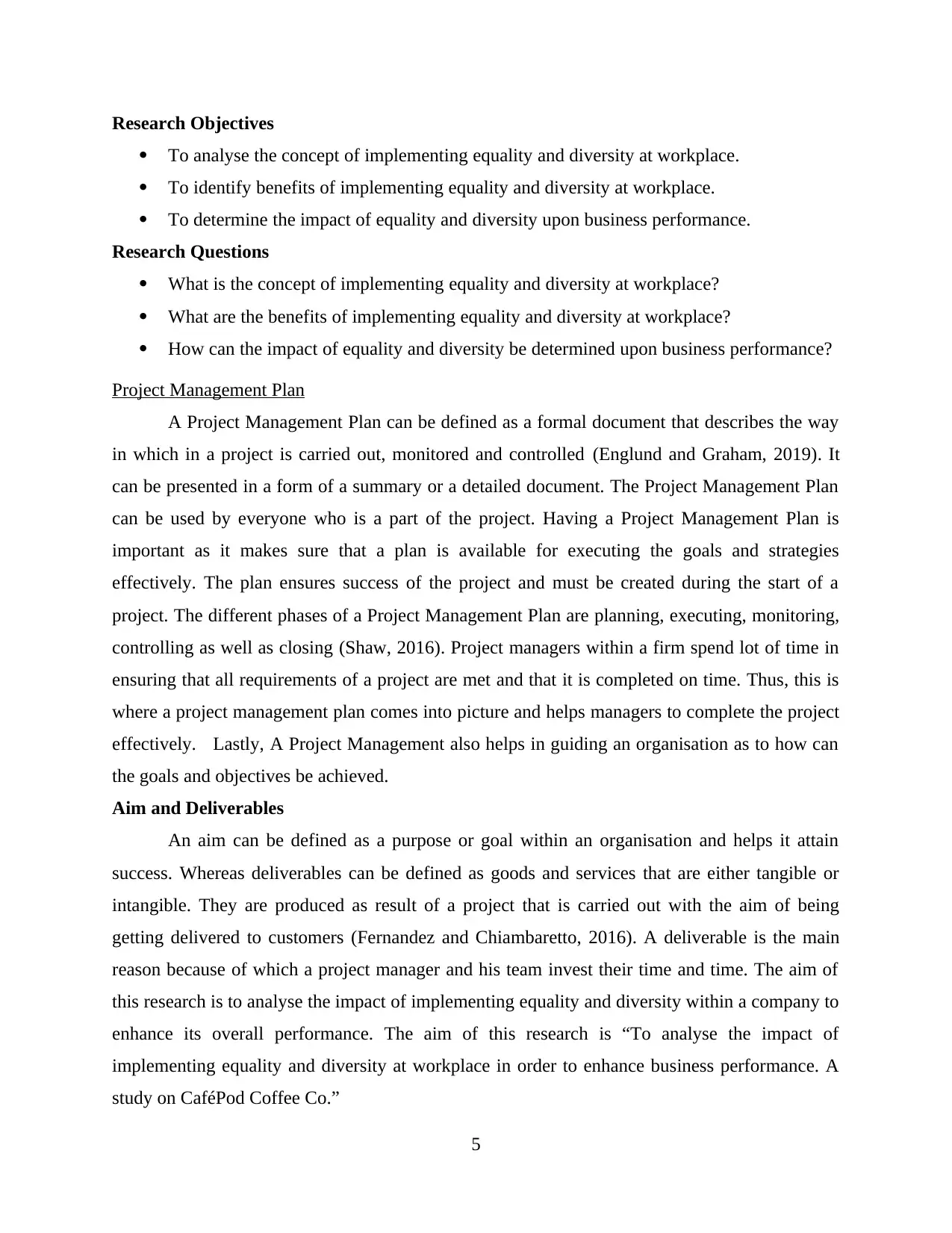
Research Objectives
To analyse the concept of implementing equality and diversity at workplace.
To identify benefits of implementing equality and diversity at workplace.
To determine the impact of equality and diversity upon business performance.
Research Questions
What is the concept of implementing equality and diversity at workplace?
What are the benefits of implementing equality and diversity at workplace?
How can the impact of equality and diversity be determined upon business performance?
Project Management Plan
A Project Management Plan can be defined as a formal document that describes the way
in which in a project is carried out, monitored and controlled (Englund and Graham, 2019). It
can be presented in a form of a summary or a detailed document. The Project Management Plan
can be used by everyone who is a part of the project. Having a Project Management Plan is
important as it makes sure that a plan is available for executing the goals and strategies
effectively. The plan ensures success of the project and must be created during the start of a
project. The different phases of a Project Management Plan are planning, executing, monitoring,
controlling as well as closing (Shaw, 2016). Project managers within a firm spend lot of time in
ensuring that all requirements of a project are met and that it is completed on time. Thus, this is
where a project management plan comes into picture and helps managers to complete the project
effectively. Lastly, A Project Management also helps in guiding an organisation as to how can
the goals and objectives be achieved.
Aim and Deliverables
An aim can be defined as a purpose or goal within an organisation and helps it attain
success. Whereas deliverables can be defined as goods and services that are either tangible or
intangible. They are produced as result of a project that is carried out with the aim of being
getting delivered to customers (Fernandez and Chiambaretto, 2016). A deliverable is the main
reason because of which a project manager and his team invest their time and time. The aim of
this research is to analyse the impact of implementing equality and diversity within a company to
enhance its overall performance. The aim of this research is “To analyse the impact of
implementing equality and diversity at workplace in order to enhance business performance. A
study on CaféPod Coffee Co.”
5
To analyse the concept of implementing equality and diversity at workplace.
To identify benefits of implementing equality and diversity at workplace.
To determine the impact of equality and diversity upon business performance.
Research Questions
What is the concept of implementing equality and diversity at workplace?
What are the benefits of implementing equality and diversity at workplace?
How can the impact of equality and diversity be determined upon business performance?
Project Management Plan
A Project Management Plan can be defined as a formal document that describes the way
in which in a project is carried out, monitored and controlled (Englund and Graham, 2019). It
can be presented in a form of a summary or a detailed document. The Project Management Plan
can be used by everyone who is a part of the project. Having a Project Management Plan is
important as it makes sure that a plan is available for executing the goals and strategies
effectively. The plan ensures success of the project and must be created during the start of a
project. The different phases of a Project Management Plan are planning, executing, monitoring,
controlling as well as closing (Shaw, 2016). Project managers within a firm spend lot of time in
ensuring that all requirements of a project are met and that it is completed on time. Thus, this is
where a project management plan comes into picture and helps managers to complete the project
effectively. Lastly, A Project Management also helps in guiding an organisation as to how can
the goals and objectives be achieved.
Aim and Deliverables
An aim can be defined as a purpose or goal within an organisation and helps it attain
success. Whereas deliverables can be defined as goods and services that are either tangible or
intangible. They are produced as result of a project that is carried out with the aim of being
getting delivered to customers (Fernandez and Chiambaretto, 2016). A deliverable is the main
reason because of which a project manager and his team invest their time and time. The aim of
this research is to analyse the impact of implementing equality and diversity within a company to
enhance its overall performance. The aim of this research is “To analyse the impact of
implementing equality and diversity at workplace in order to enhance business performance. A
study on CaféPod Coffee Co.”
5
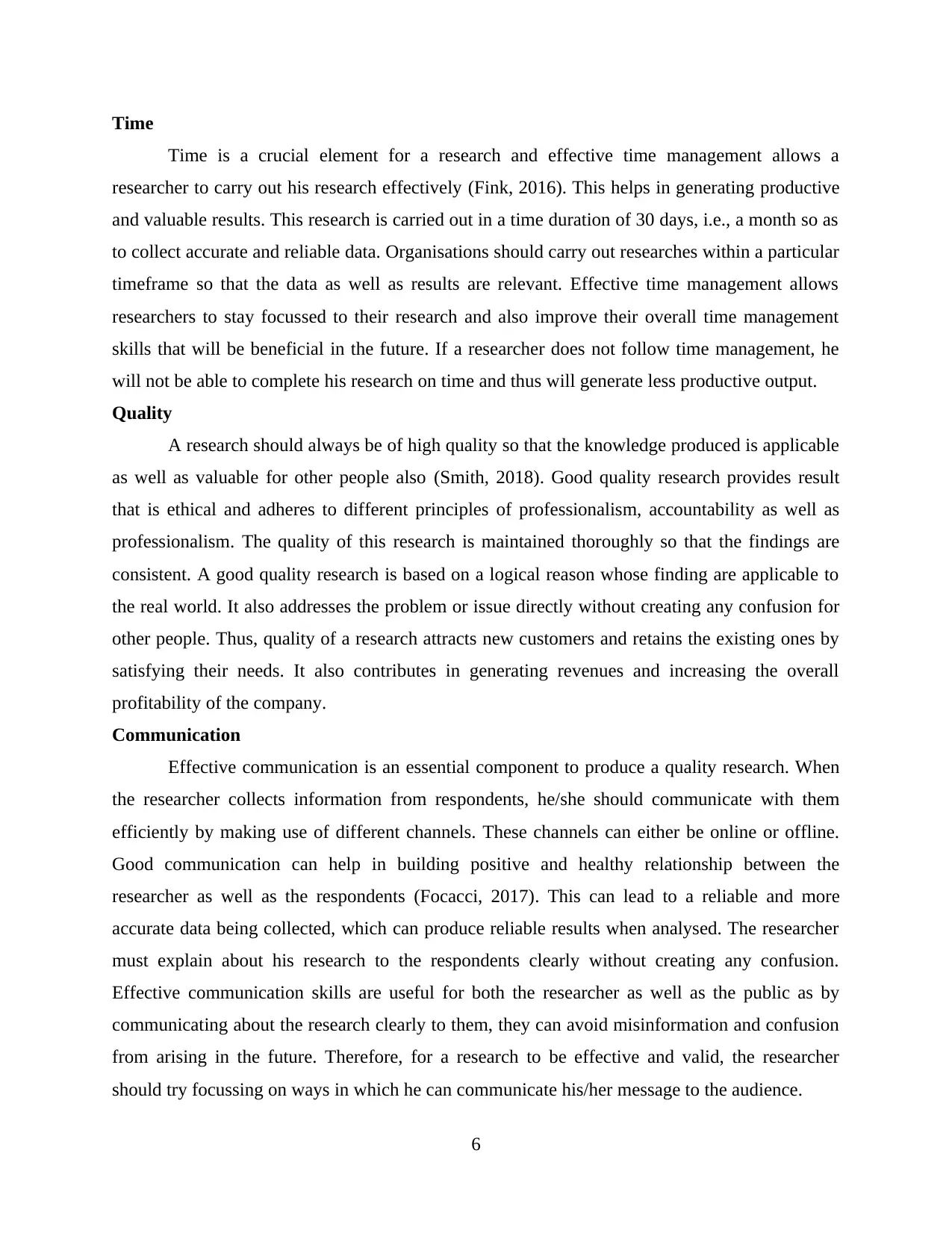
Time
Time is a crucial element for a research and effective time management allows a
researcher to carry out his research effectively (Fink, 2016). This helps in generating productive
and valuable results. This research is carried out in a time duration of 30 days, i.e., a month so as
to collect accurate and reliable data. Organisations should carry out researches within a particular
timeframe so that the data as well as results are relevant. Effective time management allows
researchers to stay focussed to their research and also improve their overall time management
skills that will be beneficial in the future. If a researcher does not follow time management, he
will not be able to complete his research on time and thus will generate less productive output.
Quality
A research should always be of high quality so that the knowledge produced is applicable
as well as valuable for other people also (Smith, 2018). Good quality research provides result
that is ethical and adheres to different principles of professionalism, accountability as well as
professionalism. The quality of this research is maintained thoroughly so that the findings are
consistent. A good quality research is based on a logical reason whose finding are applicable to
the real world. It also addresses the problem or issue directly without creating any confusion for
other people. Thus, quality of a research attracts new customers and retains the existing ones by
satisfying their needs. It also contributes in generating revenues and increasing the overall
profitability of the company.
Communication
Effective communication is an essential component to produce a quality research. When
the researcher collects information from respondents, he/she should communicate with them
efficiently by making use of different channels. These channels can either be online or offline.
Good communication can help in building positive and healthy relationship between the
researcher as well as the respondents (Focacci, 2017). This can lead to a reliable and more
accurate data being collected, which can produce reliable results when analysed. The researcher
must explain about his research to the respondents clearly without creating any confusion.
Effective communication skills are useful for both the researcher as well as the public as by
communicating about the research clearly to them, they can avoid misinformation and confusion
from arising in the future. Therefore, for a research to be effective and valid, the researcher
should try focussing on ways in which he can communicate his/her message to the audience.
6
Time is a crucial element for a research and effective time management allows a
researcher to carry out his research effectively (Fink, 2016). This helps in generating productive
and valuable results. This research is carried out in a time duration of 30 days, i.e., a month so as
to collect accurate and reliable data. Organisations should carry out researches within a particular
timeframe so that the data as well as results are relevant. Effective time management allows
researchers to stay focussed to their research and also improve their overall time management
skills that will be beneficial in the future. If a researcher does not follow time management, he
will not be able to complete his research on time and thus will generate less productive output.
Quality
A research should always be of high quality so that the knowledge produced is applicable
as well as valuable for other people also (Smith, 2018). Good quality research provides result
that is ethical and adheres to different principles of professionalism, accountability as well as
professionalism. The quality of this research is maintained thoroughly so that the findings are
consistent. A good quality research is based on a logical reason whose finding are applicable to
the real world. It also addresses the problem or issue directly without creating any confusion for
other people. Thus, quality of a research attracts new customers and retains the existing ones by
satisfying their needs. It also contributes in generating revenues and increasing the overall
profitability of the company.
Communication
Effective communication is an essential component to produce a quality research. When
the researcher collects information from respondents, he/she should communicate with them
efficiently by making use of different channels. These channels can either be online or offline.
Good communication can help in building positive and healthy relationship between the
researcher as well as the respondents (Focacci, 2017). This can lead to a reliable and more
accurate data being collected, which can produce reliable results when analysed. The researcher
must explain about his research to the respondents clearly without creating any confusion.
Effective communication skills are useful for both the researcher as well as the public as by
communicating about the research clearly to them, they can avoid misinformation and confusion
from arising in the future. Therefore, for a research to be effective and valid, the researcher
should try focussing on ways in which he can communicate his/her message to the audience.
6
⊘ This is a preview!⊘
Do you want full access?
Subscribe today to unlock all pages.

Trusted by 1+ million students worldwide
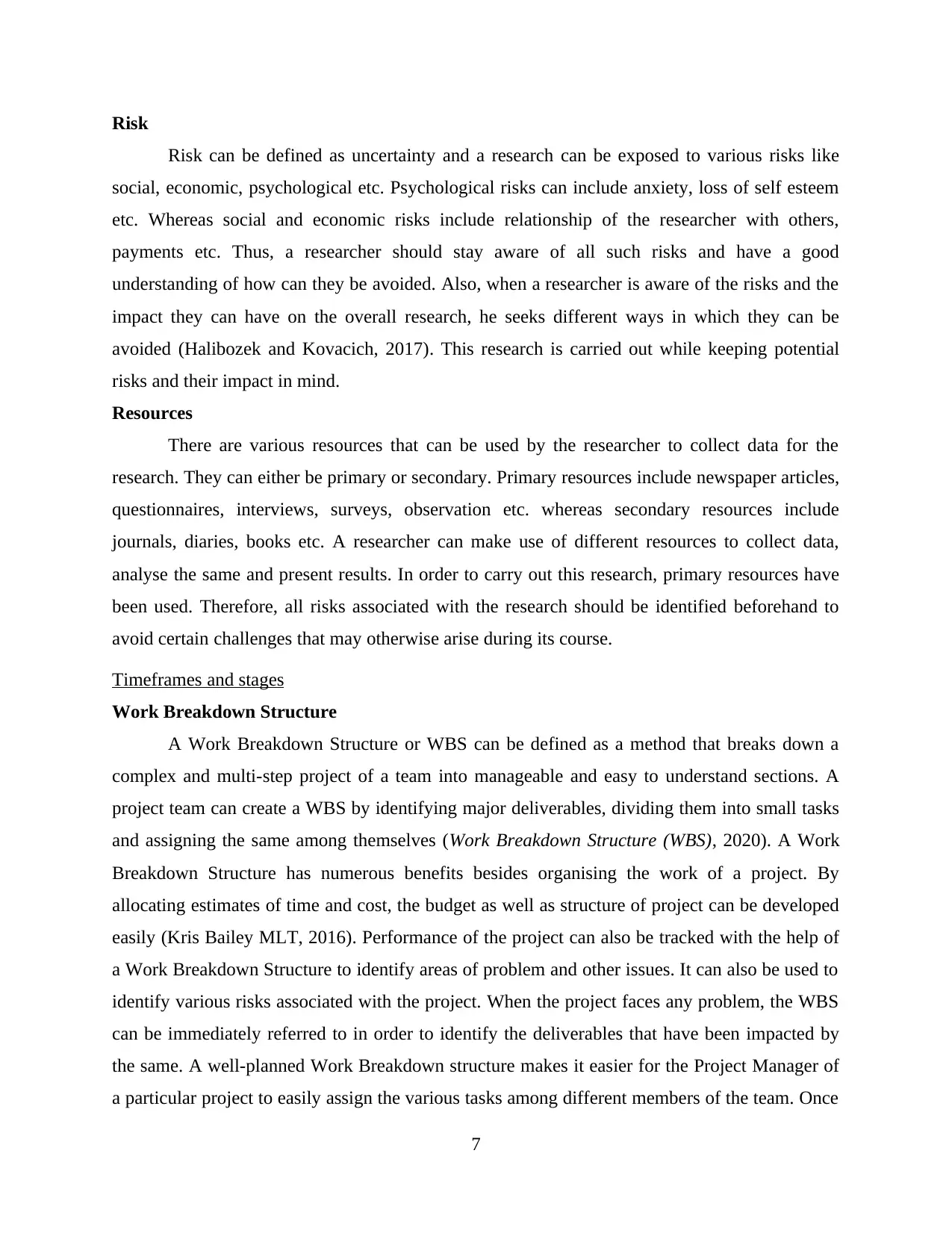
Risk
Risk can be defined as uncertainty and a research can be exposed to various risks like
social, economic, psychological etc. Psychological risks can include anxiety, loss of self esteem
etc. Whereas social and economic risks include relationship of the researcher with others,
payments etc. Thus, a researcher should stay aware of all such risks and have a good
understanding of how can they be avoided. Also, when a researcher is aware of the risks and the
impact they can have on the overall research, he seeks different ways in which they can be
avoided (Halibozek and Kovacich, 2017). This research is carried out while keeping potential
risks and their impact in mind.
Resources
There are various resources that can be used by the researcher to collect data for the
research. They can either be primary or secondary. Primary resources include newspaper articles,
questionnaires, interviews, surveys, observation etc. whereas secondary resources include
journals, diaries, books etc. A researcher can make use of different resources to collect data,
analyse the same and present results. In order to carry out this research, primary resources have
been used. Therefore, all risks associated with the research should be identified beforehand to
avoid certain challenges that may otherwise arise during its course.
Timeframes and stages
Work Breakdown Structure
A Work Breakdown Structure or WBS can be defined as a method that breaks down a
complex and multi-step project of a team into manageable and easy to understand sections. A
project team can create a WBS by identifying major deliverables, dividing them into small tasks
and assigning the same among themselves (Work Breakdown Structure (WBS), 2020). A Work
Breakdown Structure has numerous benefits besides organising the work of a project. By
allocating estimates of time and cost, the budget as well as structure of project can be developed
easily (Kris Bailey MLT, 2016). Performance of the project can also be tracked with the help of
a Work Breakdown Structure to identify areas of problem and other issues. It can also be used to
identify various risks associated with the project. When the project faces any problem, the WBS
can be immediately referred to in order to identify the deliverables that have been impacted by
the same. A well-planned Work Breakdown structure makes it easier for the Project Manager of
a particular project to easily assign the various tasks among different members of the team. Once
7
Risk can be defined as uncertainty and a research can be exposed to various risks like
social, economic, psychological etc. Psychological risks can include anxiety, loss of self esteem
etc. Whereas social and economic risks include relationship of the researcher with others,
payments etc. Thus, a researcher should stay aware of all such risks and have a good
understanding of how can they be avoided. Also, when a researcher is aware of the risks and the
impact they can have on the overall research, he seeks different ways in which they can be
avoided (Halibozek and Kovacich, 2017). This research is carried out while keeping potential
risks and their impact in mind.
Resources
There are various resources that can be used by the researcher to collect data for the
research. They can either be primary or secondary. Primary resources include newspaper articles,
questionnaires, interviews, surveys, observation etc. whereas secondary resources include
journals, diaries, books etc. A researcher can make use of different resources to collect data,
analyse the same and present results. In order to carry out this research, primary resources have
been used. Therefore, all risks associated with the research should be identified beforehand to
avoid certain challenges that may otherwise arise during its course.
Timeframes and stages
Work Breakdown Structure
A Work Breakdown Structure or WBS can be defined as a method that breaks down a
complex and multi-step project of a team into manageable and easy to understand sections. A
project team can create a WBS by identifying major deliverables, dividing them into small tasks
and assigning the same among themselves (Work Breakdown Structure (WBS), 2020). A Work
Breakdown Structure has numerous benefits besides organising the work of a project. By
allocating estimates of time and cost, the budget as well as structure of project can be developed
easily (Kris Bailey MLT, 2016). Performance of the project can also be tracked with the help of
a Work Breakdown Structure to identify areas of problem and other issues. It can also be used to
identify various risks associated with the project. When the project faces any problem, the WBS
can be immediately referred to in order to identify the deliverables that have been impacted by
the same. A well-planned Work Breakdown structure makes it easier for the Project Manager of
a particular project to easily assign the various tasks among different members of the team. Once
7
Paraphrase This Document
Need a fresh take? Get an instant paraphrase of this document with our AI Paraphraser
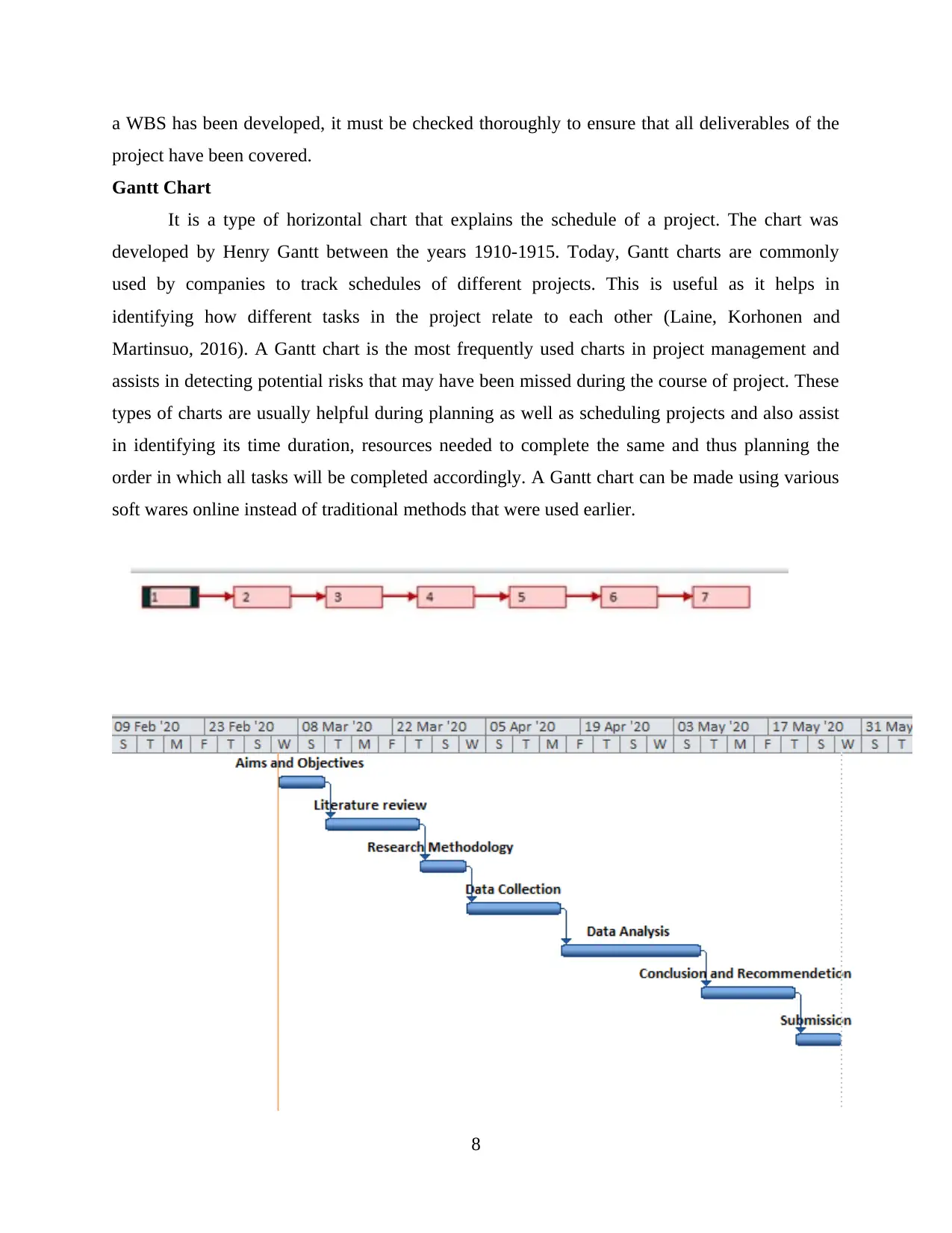
a WBS has been developed, it must be checked thoroughly to ensure that all deliverables of the
project have been covered.
Gantt Chart
It is a type of horizontal chart that explains the schedule of a project. The chart was
developed by Henry Gantt between the years 1910-1915. Today, Gantt charts are commonly
used by companies to track schedules of different projects. This is useful as it helps in
identifying how different tasks in the project relate to each other (Laine, Korhonen and
Martinsuo, 2016). A Gantt chart is the most frequently used charts in project management and
assists in detecting potential risks that may have been missed during the course of project. These
types of charts are usually helpful during planning as well as scheduling projects and also assist
in identifying its time duration, resources needed to complete the same and thus planning the
order in which all tasks will be completed accordingly. A Gantt chart can be made using various
soft wares online instead of traditional methods that were used earlier.
8
project have been covered.
Gantt Chart
It is a type of horizontal chart that explains the schedule of a project. The chart was
developed by Henry Gantt between the years 1910-1915. Today, Gantt charts are commonly
used by companies to track schedules of different projects. This is useful as it helps in
identifying how different tasks in the project relate to each other (Laine, Korhonen and
Martinsuo, 2016). A Gantt chart is the most frequently used charts in project management and
assists in detecting potential risks that may have been missed during the course of project. These
types of charts are usually helpful during planning as well as scheduling projects and also assist
in identifying its time duration, resources needed to complete the same and thus planning the
order in which all tasks will be completed accordingly. A Gantt chart can be made using various
soft wares online instead of traditional methods that were used earlier.
8
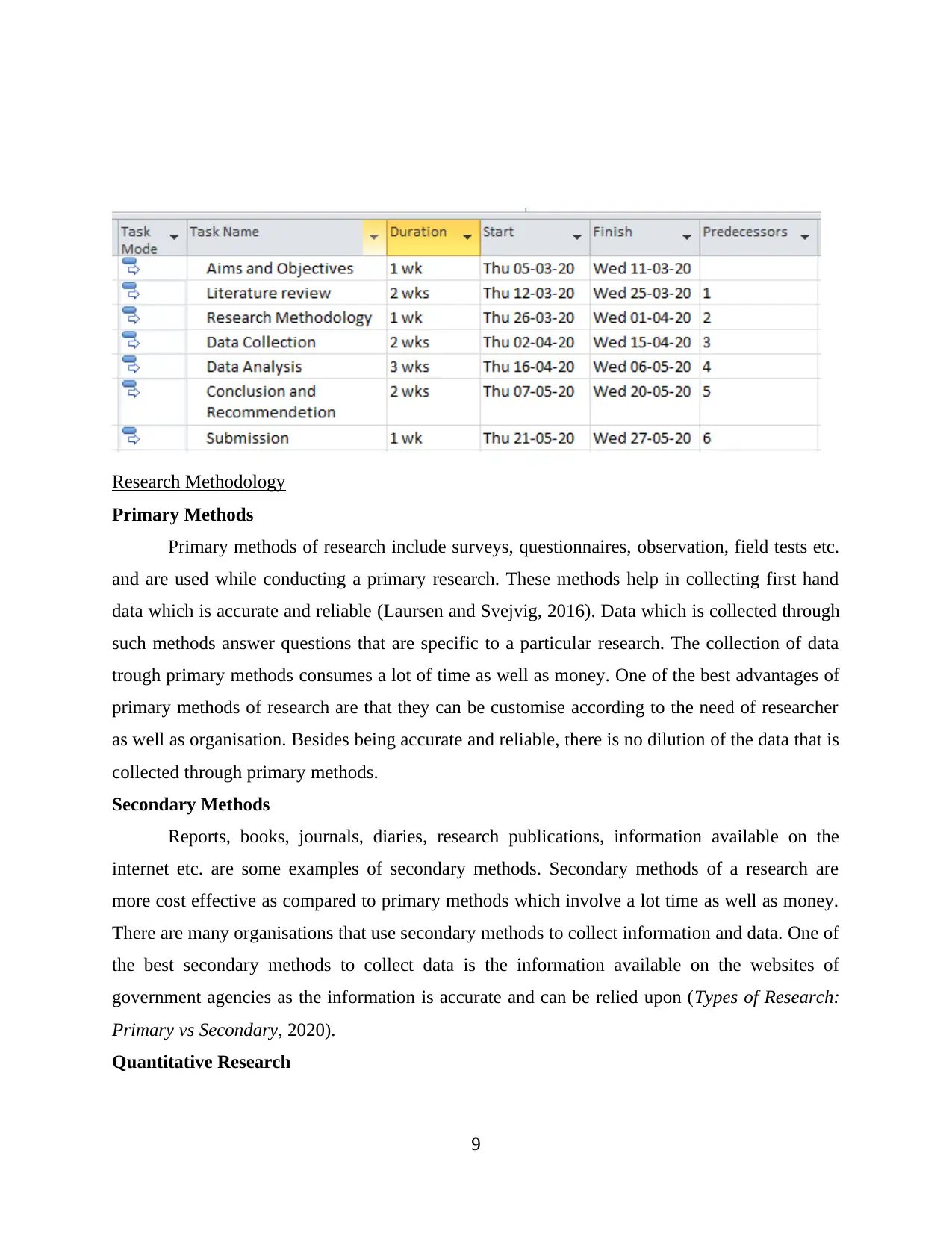
Research Methodology
Primary Methods
Primary methods of research include surveys, questionnaires, observation, field tests etc.
and are used while conducting a primary research. These methods help in collecting first hand
data which is accurate and reliable (Laursen and Svejvig, 2016). Data which is collected through
such methods answer questions that are specific to a particular research. The collection of data
trough primary methods consumes a lot of time as well as money. One of the best advantages of
primary methods of research are that they can be customise according to the need of researcher
as well as organisation. Besides being accurate and reliable, there is no dilution of the data that is
collected through primary methods.
Secondary Methods
Reports, books, journals, diaries, research publications, information available on the
internet etc. are some examples of secondary methods. Secondary methods of a research are
more cost effective as compared to primary methods which involve a lot time as well as money.
There are many organisations that use secondary methods to collect information and data. One of
the best secondary methods to collect data is the information available on the websites of
government agencies as the information is accurate and can be relied upon (Types of Research:
Primary vs Secondary, 2020).
Quantitative Research
9
Primary Methods
Primary methods of research include surveys, questionnaires, observation, field tests etc.
and are used while conducting a primary research. These methods help in collecting first hand
data which is accurate and reliable (Laursen and Svejvig, 2016). Data which is collected through
such methods answer questions that are specific to a particular research. The collection of data
trough primary methods consumes a lot of time as well as money. One of the best advantages of
primary methods of research are that they can be customise according to the need of researcher
as well as organisation. Besides being accurate and reliable, there is no dilution of the data that is
collected through primary methods.
Secondary Methods
Reports, books, journals, diaries, research publications, information available on the
internet etc. are some examples of secondary methods. Secondary methods of a research are
more cost effective as compared to primary methods which involve a lot time as well as money.
There are many organisations that use secondary methods to collect information and data. One of
the best secondary methods to collect data is the information available on the websites of
government agencies as the information is accurate and can be relied upon (Types of Research:
Primary vs Secondary, 2020).
Quantitative Research
9
⊘ This is a preview!⊘
Do you want full access?
Subscribe today to unlock all pages.

Trusted by 1+ million students worldwide
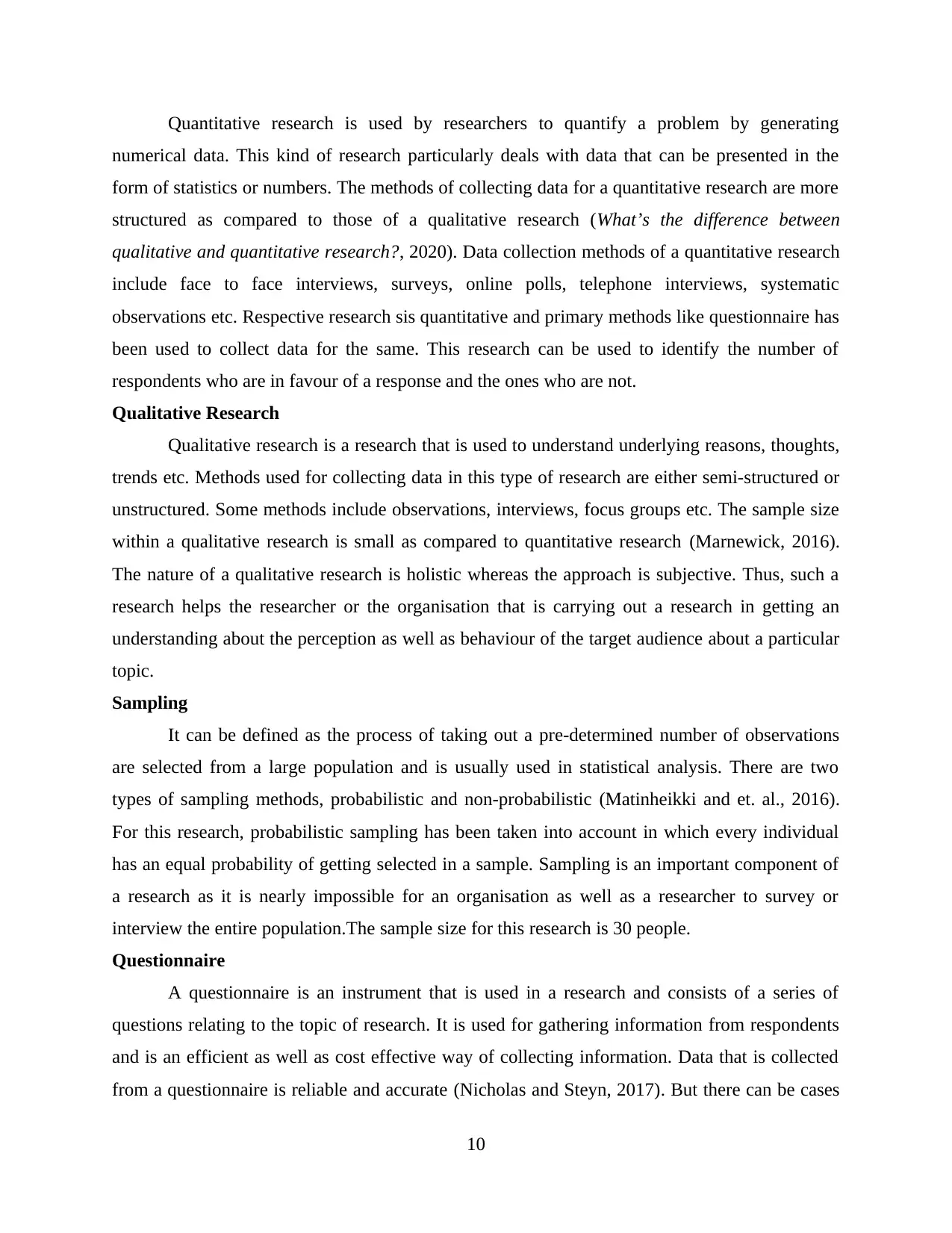
Quantitative research is used by researchers to quantify a problem by generating
numerical data. This kind of research particularly deals with data that can be presented in the
form of statistics or numbers. The methods of collecting data for a quantitative research are more
structured as compared to those of a qualitative research (What’s the difference between
qualitative and quantitative research?, 2020). Data collection methods of a quantitative research
include face to face interviews, surveys, online polls, telephone interviews, systematic
observations etc. Respective research sis quantitative and primary methods like questionnaire has
been used to collect data for the same. This research can be used to identify the number of
respondents who are in favour of a response and the ones who are not.
Qualitative Research
Qualitative research is a research that is used to understand underlying reasons, thoughts,
trends etc. Methods used for collecting data in this type of research are either semi-structured or
unstructured. Some methods include observations, interviews, focus groups etc. The sample size
within a qualitative research is small as compared to quantitative research (Marnewick, 2016).
The nature of a qualitative research is holistic whereas the approach is subjective. Thus, such a
research helps the researcher or the organisation that is carrying out a research in getting an
understanding about the perception as well as behaviour of the target audience about a particular
topic.
Sampling
It can be defined as the process of taking out a pre-determined number of observations
are selected from a large population and is usually used in statistical analysis. There are two
types of sampling methods, probabilistic and non-probabilistic (Matinheikki and et. al., 2016).
For this research, probabilistic sampling has been taken into account in which every individual
has an equal probability of getting selected in a sample. Sampling is an important component of
a research as it is nearly impossible for an organisation as well as a researcher to survey or
interview the entire population.The sample size for this research is 30 people.
Questionnaire
A questionnaire is an instrument that is used in a research and consists of a series of
questions relating to the topic of research. It is used for gathering information from respondents
and is an efficient as well as cost effective way of collecting information. Data that is collected
from a questionnaire is reliable and accurate (Nicholas and Steyn, 2017). But there can be cases
10
numerical data. This kind of research particularly deals with data that can be presented in the
form of statistics or numbers. The methods of collecting data for a quantitative research are more
structured as compared to those of a qualitative research (What’s the difference between
qualitative and quantitative research?, 2020). Data collection methods of a quantitative research
include face to face interviews, surveys, online polls, telephone interviews, systematic
observations etc. Respective research sis quantitative and primary methods like questionnaire has
been used to collect data for the same. This research can be used to identify the number of
respondents who are in favour of a response and the ones who are not.
Qualitative Research
Qualitative research is a research that is used to understand underlying reasons, thoughts,
trends etc. Methods used for collecting data in this type of research are either semi-structured or
unstructured. Some methods include observations, interviews, focus groups etc. The sample size
within a qualitative research is small as compared to quantitative research (Marnewick, 2016).
The nature of a qualitative research is holistic whereas the approach is subjective. Thus, such a
research helps the researcher or the organisation that is carrying out a research in getting an
understanding about the perception as well as behaviour of the target audience about a particular
topic.
Sampling
It can be defined as the process of taking out a pre-determined number of observations
are selected from a large population and is usually used in statistical analysis. There are two
types of sampling methods, probabilistic and non-probabilistic (Matinheikki and et. al., 2016).
For this research, probabilistic sampling has been taken into account in which every individual
has an equal probability of getting selected in a sample. Sampling is an important component of
a research as it is nearly impossible for an organisation as well as a researcher to survey or
interview the entire population.The sample size for this research is 30 people.
Questionnaire
A questionnaire is an instrument that is used in a research and consists of a series of
questions relating to the topic of research. It is used for gathering information from respondents
and is an efficient as well as cost effective way of collecting information. Data that is collected
from a questionnaire is reliable and accurate (Nicholas and Steyn, 2017). But there can be cases
10
Paraphrase This Document
Need a fresh take? Get an instant paraphrase of this document with our AI Paraphraser
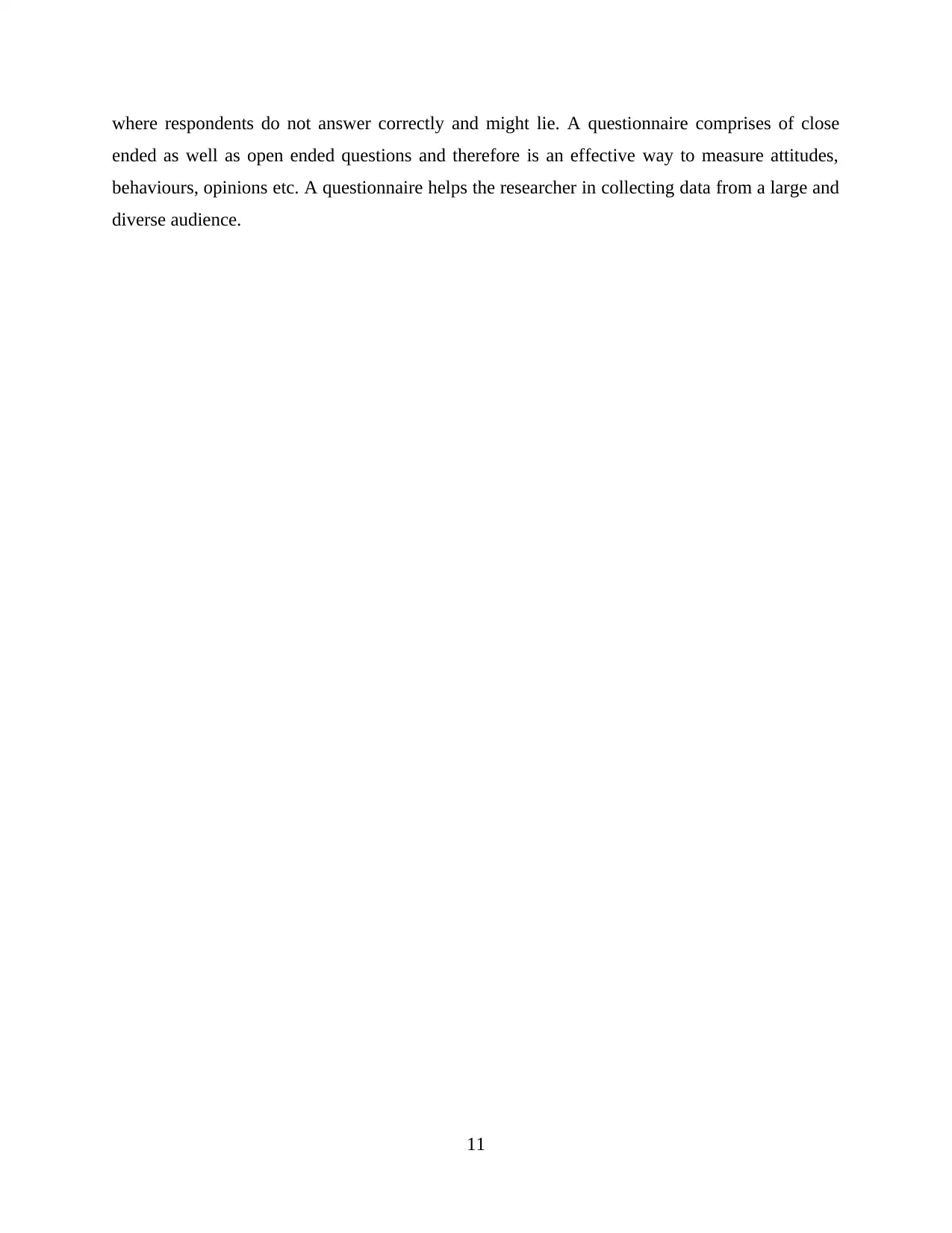
where respondents do not answer correctly and might lie. A questionnaire comprises of close
ended as well as open ended questions and therefore is an effective way to measure attitudes,
behaviours, opinions etc. A questionnaire helps the researcher in collecting data from a large and
diverse audience.
11
ended as well as open ended questions and therefore is an effective way to measure attitudes,
behaviours, opinions etc. A questionnaire helps the researcher in collecting data from a large and
diverse audience.
11
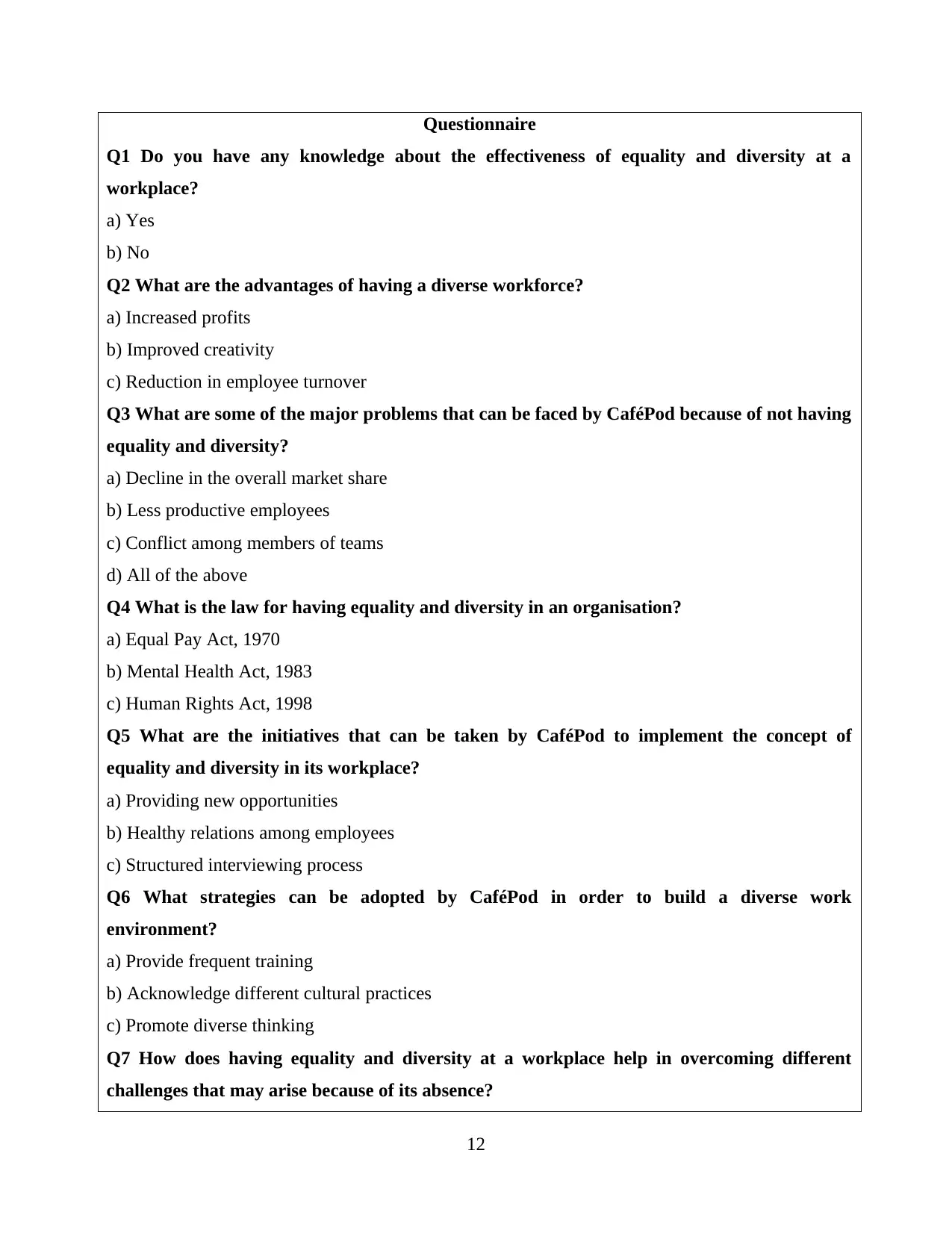
Questionnaire
Q1 Do you have any knowledge about the effectiveness of equality and diversity at a
workplace?
a) Yes
b) No
Q2 What are the advantages of having a diverse workforce?
a) Increased profits
b) Improved creativity
c) Reduction in employee turnover
Q3 What are some of the major problems that can be faced by CaféPod because of not having
equality and diversity?
a) Decline in the overall market share
b) Less productive employees
c) Conflict among members of teams
d) All of the above
Q4 What is the law for having equality and diversity in an organisation?
a) Equal Pay Act, 1970
b) Mental Health Act, 1983
c) Human Rights Act, 1998
Q5 What are the initiatives that can be taken by CaféPod to implement the concept of
equality and diversity in its workplace?
a) Providing new opportunities
b) Healthy relations among employees
c) Structured interviewing process
Q6 What strategies can be adopted by CaféPod in order to build a diverse work
environment?
a) Provide frequent training
b) Acknowledge different cultural practices
c) Promote diverse thinking
Q7 How does having equality and diversity at a workplace help in overcoming different
challenges that may arise because of its absence?
12
Q1 Do you have any knowledge about the effectiveness of equality and diversity at a
workplace?
a) Yes
b) No
Q2 What are the advantages of having a diverse workforce?
a) Increased profits
b) Improved creativity
c) Reduction in employee turnover
Q3 What are some of the major problems that can be faced by CaféPod because of not having
equality and diversity?
a) Decline in the overall market share
b) Less productive employees
c) Conflict among members of teams
d) All of the above
Q4 What is the law for having equality and diversity in an organisation?
a) Equal Pay Act, 1970
b) Mental Health Act, 1983
c) Human Rights Act, 1998
Q5 What are the initiatives that can be taken by CaféPod to implement the concept of
equality and diversity in its workplace?
a) Providing new opportunities
b) Healthy relations among employees
c) Structured interviewing process
Q6 What strategies can be adopted by CaféPod in order to build a diverse work
environment?
a) Provide frequent training
b) Acknowledge different cultural practices
c) Promote diverse thinking
Q7 How does having equality and diversity at a workplace help in overcoming different
challenges that may arise because of its absence?
12
⊘ This is a preview!⊘
Do you want full access?
Subscribe today to unlock all pages.

Trusted by 1+ million students worldwide
1 out of 22
Related Documents
Your All-in-One AI-Powered Toolkit for Academic Success.
+13062052269
info@desklib.com
Available 24*7 on WhatsApp / Email
![[object Object]](/_next/static/media/star-bottom.7253800d.svg)
Unlock your academic potential
Copyright © 2020–2025 A2Z Services. All Rights Reserved. Developed and managed by ZUCOL.





